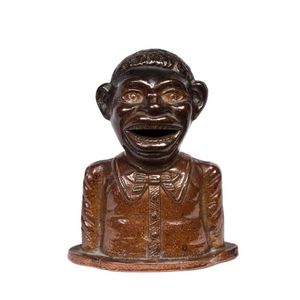Lithgow Pottery Jolly Nigger Bank Money Box
You must be a subscriber, and be logged in to view price and dealer details.
Subscribe Now to view actual auction price for this item
When you subscribe, you have the option of setting the currency in which to display prices to $Au, $US, $NZ or Stg.
- Salt Glazed - Salt glazing involves throwing salt into the kiln when it is at its highest temperature, usually around 2,300 to 2,400 degrees Fahrenheit (1,260 to 1,320 degrees Celsius). The salt vaporizes and forms a glaze on the surface of the pottery, creating a range of effects depending on how the salt is applied and the firing conditions. This glazing method was first developed in Germany in the 15th century and quickly became popular throughout Europe and North America. It was particularly popular for making stoneware pottery, such as jugs, crocks, and other utilitarian objects.
Salt glazes can produce a range of colors, including gray, brown, blue, and even pink or purple in some cases. The texture of the glaze is typically rough and pebbled, with a matte or satin finish. The process of salt glazing can be unpredictable, with variations in temperature and salt application leading to subtle variations in the finished product.
Salt glazing is still used by potters and ceramic artists although it is less common than it was in the past. - Incised - A record of a name, date or inscription, or a decoration scratched into a surface, usually of a glass or ceramic item with a blunt instrument to make a coarse indentation. Compare with engraving where the surface is cut with a sharp instrument such as a metal needle or rotating tool to achieve a fine indentation.
- Circa - A Latin term meaning 'about', often used in the antique trade to give an approximate date for the piece, usually considered to be five years on either side of the circa year. Thus, circa 1900 means the piece was made about 1900, probably between 1895 and 1905. The expression is sometimes abbreviated to c.1900.
This item has been included into following indexes:
Visually similar items

A Japanese giltwood image of Buddha sitting upon a tiered throne, Meiji period. IIncense smoke patina and gilt traces. Height 27 cm

Don Bradman, Bendigo Pottery 'Sir Don Bradman' caricature jug, very attractive with olive-green glaze, 15 cm high. Limited edition 619/3000.

A carved tribal figure with shell eyes & Kina shell necklace, Japandie village, Sepik river, Papua New Guinea, height 138 cm

An 18th century figure of Bala krishna Kaliya, south India, standing on a cobra head with a butterball in one hand, 12 cm high
